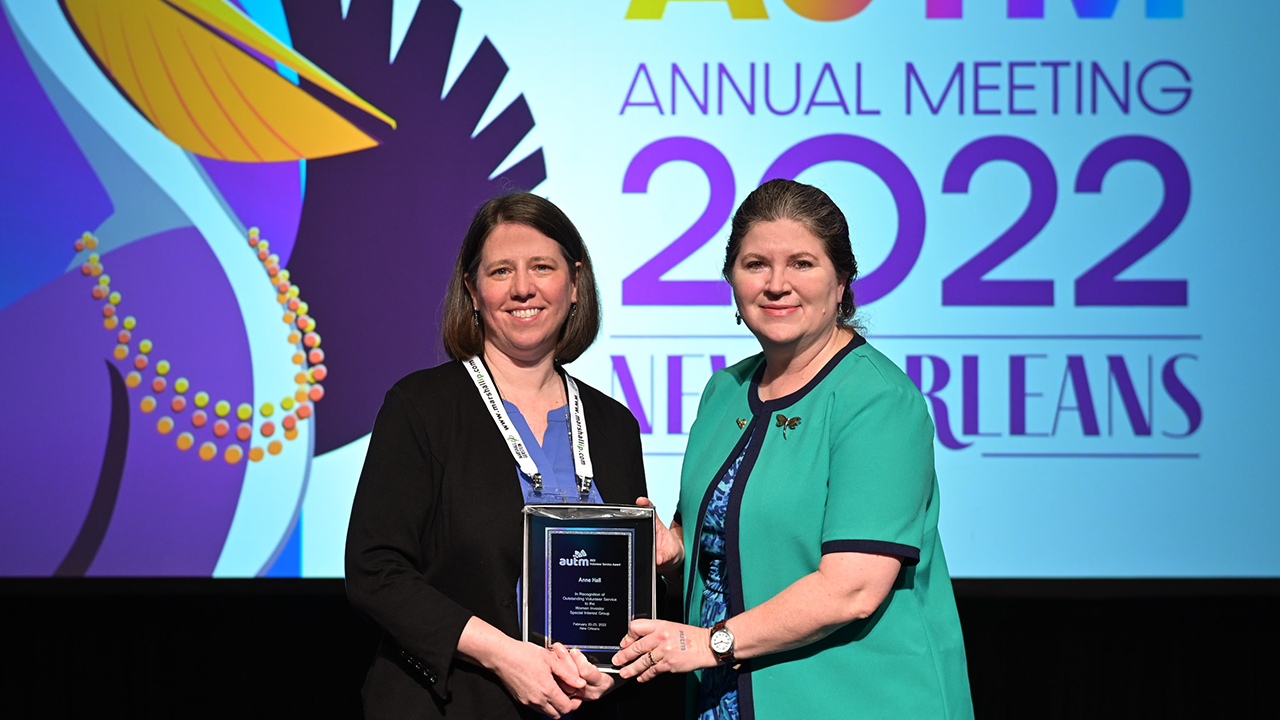
Anne Hall receives a Volunteer Service Award for her work with the Women’s Inventor Special Interest Group.
As universities increasingly recognize the importance of inclusivity and diversity in academia, Anne Hall and others at Tech Comm use data analysis, targeted programming, and broader representation to lead the way to a more equitable innovation ecosystem.
Tech Comm’s Anne Hall Receives Award for Diversity Work at National Conference
At the AUTM annual meeting in February, Anne Hall, a senior technology portfolio manager with UMN Technology Commercialization (Tech Comm), received a Volunteer Service Award for her work with the Women’s Inventor Special Interest Group (WISIG), which strives to increase the participation rate of women inventors in tech transfer and entrepreneurship activities.
Hall's work focused on analyzing data from nearly 200 United States universities regarding women’s participation in tech transfer, which was compiled by AUTM, the professional association for academic technology transfer professionals. In 2015, the association began asking university technology transfer offices (TTOs) to submit yearly data on the number of women involved in invention disclosures and patent filings as part of AUTM’s yearly survey, but had yet to analyze the data and develop recommendations.
Hall’s interest in analyzing the national AUTM gender data dovetailed with another local initiative happening within the cross-departmental Innovation Ecosystem Diversity, Equity, and Inclusion (DEI) working group at the University of Minnesota. This group, led by Hall and Tech Comm’s Venture Program Manager Mary MacCarthy, was also gathering and analyzing women researchers' participation in invention disclosures and patenting data from across the University.
Analyses of both sets of data, along with recommended steps to help bridge the gaps in participation between male and female innovators, were presented at the AUTM annual meeting by Hall and other members of the WISIG.
Data Analysis for the First Time
The WISIG’s analysis of the AUTM gender data showed that, over six years among nearly 200 institutions, there was a significant participation gap between men and women in key tech transfer activities. On average, the data showed that just 32% of invention disclosures and 21% of patent filings included at least one woman. While the gap between male and female participation is large, the WISIG recommends turning attention and resources to scaling regional programs targeted at women and other underrepresented innovators at a national level to create significant change.
At the University, Hall and MacCarthy worked on data analysis with OVPR colleagues, including Josh Miraglia and Vern Wehrle with the Office of Research Information Systems, Tech Comm colleagues Phil Snyder and Guru Venkatesan, and former Tech Comm intern Lisa Fazzino. They found that 36% of both invention disclosures and patent filings at the University had at least one woman, exceeding the average of the AUTM community. They also looked at women’s participation on a more granular level and discerned that gaps in women’s participation differed across colleges and was not merely a lack of overall female representation.
How Gender Data Can Drive Positive Change in Tech Transfer
After Hall’s presentation at the national meeting, AUTM agreed to begin publishing the gender data they collect yearly from universities to provide greater transparency and allow institutions to see how they compare to peers. Hall and the WISIG also plan to share best practices with the AUTM community so institutions can better track gender data.
At the University, Hall and the Innovation Ecosystem DEI working group want to talk to different colleges about their level of women’s participation and brainstorm ways to get more women involved in the innovation process. Now that the University has started tracking the data, it will be easier to see how targeted programs can drive improvement.
“We found that, in many cases, the lower level of women’s participation isn’t because there are fewer women in academia,” Hall explained. “It’s that we haven’t attracted women into the innovation process yet.”
Why Is Diversity, Equity, and Inclusion Important to Tech Comm?
“Tech Comm’s mission is to get as many technologies out into the world as possible,” Hall explained. “We know that women researchers are innovative, creative, and come up with valuable solutions. If we’re not working with those women, we’re not getting their ideas out there.”
A 2021 article in Science found that researchers tend to patent inventions focused on the needs and interests of their own social group. In other words, women are more likely to make scientific discoveries that benefit women, which is why innovator representation is important among all social groups.
Tech Comm’s Steps to Increase Diversity, Equity, and Inclusion
Tech Comm has been taking specific approaches to improve diversity, equity and inclusion in tech transfer. In 2021, the unit was able to diversify the membership of its Business Advisory Group, a group of volunteer business mentors who advise researchers working to commercialize their innovations. The group now includes more women and people of color, providing a richer depth of experiences and voices to advise University researchers and Tech Comm.
The unit has also been telling the stories of more diverse innovators and working with partners within the University’s innovation ecosystem on programming targeted at women, such as the Women Innovators Conference hosted by the Holmes Center for Entrepreneurship. In 2021, Tech Comm collaborated with Carla Pavone of the Holmes Center on two new programs: an Inclusive Innovator’s Forum, which provides education and mentoring on commercialization for under-represented innovators, and a mentoring circle to educate women graduate students and postdocs about the innovation process.
“The end goal is not to be getting better at tracking numbers but to have an inclusive innovation system, where all possible innovators are participating, including women,” said Hall. “At some point, I hope that tracking the numbers becomes much less important.”